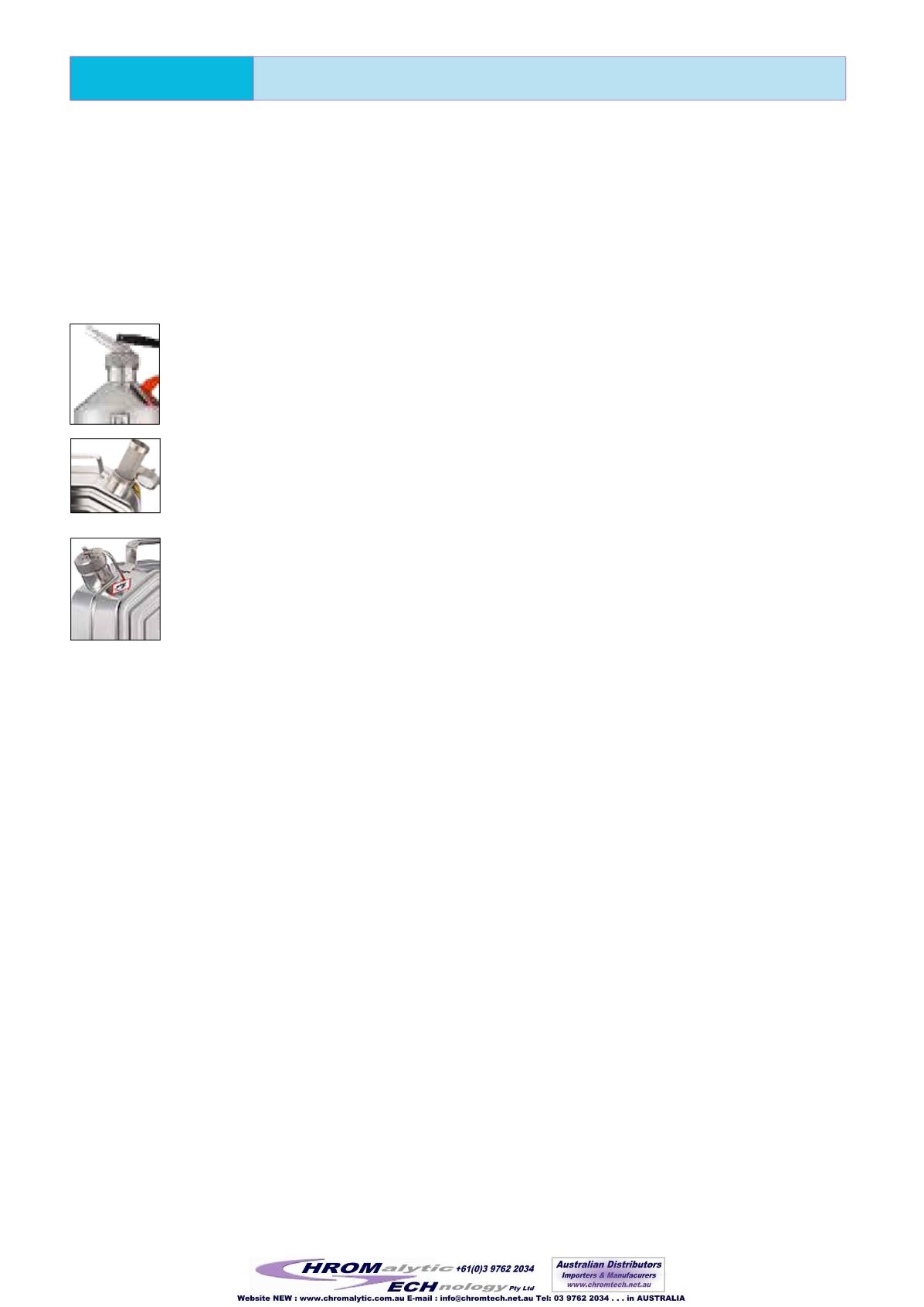
Product Information
SAETY CONTAINERS
Our safety containers are made of austenitic stainless steel. Typical uses include:
●
Industrial production processes
●
Laboratory containers at universities, research institutions and in industry
●
Storage containers for safe storage of hazardous materials
●
Transportation containers for transporting dangerous goods on public roads
●
etc.
Features:
Self-closing closures
(metering devices and taps): open during operation only.
Close automatically by spring force after usage or when containers are dropped accidentally (e.g.
in emergencies). This prevents contamination and hazards due to uncontrolled spillage as well as
additional fire spreading. Similarly, uncontrolled release of harmful or flammable vapors is avoided.
Various features of our products provide maximum safety for users working with flammable liquids. At the same time,
our products ensure effective fire and environmental protection. The use of our products is explicitly recommended by
the German Occupational Safety and Health Administration (section 4.15.1 of the laboratory directive, TRGS 526).
Flame arrester:
Prevents ignition sparks from entering even when the container is open, therefore
protecting the container and it’s content against explosion. Consists of a special stainless steel mesh
(called Davy Filter), which protects safely from contact with sparks (e.g. due to static electricity when
filling or emptying) and flames (e.g. due to fire accidents during operation). The flame arrester is easily
removable (for cleaning or replacement).
Pressure compensation:
Pressure control valves (in metering devices and screw caps) allow excess
pressure in closed containers to escape automatically and thus protect against explosion
(explosion-proof containers). The mechanism is activated automatically at an excess pressure of 0.3 to
0.4 bar. Excess pressure may result of chemical reactions by the substances filled, thermal influences
(e.g. solar radiation, fire), frictions or mechanical hits. Once excess pressure escaped, the valve
automatically closes again. Repairs and ongoing maintenance of other solutions (e.g. as fusible links)
are no longer necessary.
Materials and chemical resistance of safety containers:
Material:
316 Ti (1.4571) or 304 (1.4301, for 20 litre canister).
DIN:
X6 and X5 CrNi 18-10 CrNiMoTi 17-12-2.
Certificate:
EN 10204/3.1B.
Seals:
Polytetrafluoroethylene (PTFE).
For each product a technical datasheet can be downloaded from our website. It includes information on materials
used, dimensions, weights, etc. The stainless steels used are characterised by particularly high resistance against
corrosive substances. This allows for a much longer usage of stainless steel containers compared to containers made of
other materials (e.g. steel or plastic). A rich chromium surface of metal oxides and hydroxides (passive layer) separates
and protects the stainless steel from aggressive substances. The passive layer typically recovers itself in the event of a
mechanical damage of it’s surface. The range of substances that can be used in our stainless steel containers includes
chemical products, acids, food, alcohol, oils, etc. A selection of substances can be found in the table below
(“technically pure substances”, i.e. no additions). Resistance may also be given for mixed substances - since the
resulting chemical reactions depend on individual conditions, a case to case evaluation need to be done by the user
her-/himself.
Limitations regarding the resistance of stainless steel exist with substances which destroy the passive layer, e.g. a few
chlorine, chlorine compounds or reducing acids. The company ThyssenKrupp Nirosta GmbH, supplier of stainless steels
our company uses, publishes lists regarding the chemical resistance of various types of stainless steel. The German
Institute for Standardization also publishes a comparable list (DIN 6601, so-called positive list). The table below shows
the chemical resistance of stainless steel types used for our products against major substances (commercially
available, technically pure) and is based on the two lists mentioned above. It does not apply to wastes or mixtures that
have an indefinite number and concentration of admixtures and impurities. Known limitations have been added to
column “Remarks”.
Our conical special gaskets of our safety containers are made of polytetrafluoroethylene (PTFE). PTFE also is highly
chemically resistant and subject virtually only to mechanical abrasion. The following table shows the resistance of PTFE
for a variety of substances.
Grounding:
During filling or emptying of containers electric charges may occur by friction (static electricity). Sparks
could lead to inflammation or explosions of containers. On the one hand MRC Safety Containers protect you through
integrated flame arresters and pressure control valves. Additionally the containers are fully conductive and charges
are automatically derived.
Robust materials and construction:
The stainless steels used as well as the gaskets and all other materials are of very
high quality and very durable. If used properly, the containers can be used for decades. Our products offer high
robustness and extreme breaking resistance during daily operations.
Overfill protection:
Whenever you use our safety funnels they prevent overfilling automatically. Overall these funnels
take only the amount of liquids that fits into the container.
288


